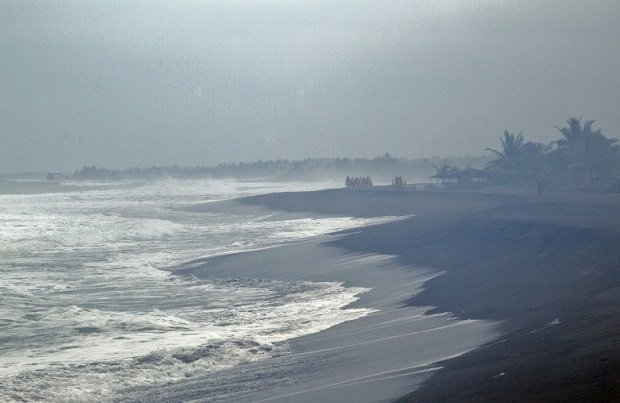
Waves break on the beach in Boca de Pascuales, Colima State, Mexico, on October 22, 2015. Fast-moving Patricia grew into an “extremely dangerous” major hurricane off Mexico’s Pacific coast on Thursday, forecasters said, warning of possible landslides and flash flooding. AFP
The strongest hurricane ever recorded crashed into Mexico’s Pacific coast on Friday, ratcheting up fears that super storm Patricia will unleash death and destruction with its powerful winds and driving rain.
Authorities relocated coastal residents, closed ports and schools in several states and evacuated tourists from beach hotels before the category five monster hurricane made landfall in the western state of Jalisco.
People boarded up windows and bought water and food supplies as they hunkered down for the storm and urgently sought shelter.
The hurricane made landfall in the town of Emiliano Zapata, about 95 kilometers (60 miles) west of the major port of Manzanillo, National Water Commission director Roberto Ramirez told Milenio television.
The US National Hurricane Center said Patricia weakened marginally at landfall, but was still packing maximum winds of 270 kilometers per hour.
READ: Mexico’s Pacific Coast braces for monster Hurricane Patricia
It peaked at 325 kilometers per hour several hours earlier — even more powerful than the 315 kph winds of Super Typhoon Haiyan, which left more than 7,350 dead or missing when it struck the Philippines in November 2013.
“We are facing a natural phenomenon, a force that we have never seen before” in the world, President Enrique Pena Nieto told Radio Formula earlier in the day. “We will face difficult moments.”
Warning of a “threat of great scale,” Pena Nieto said the government’s priority is to “protect and save the lives of Mexicans.”
Rain and wind lashed the coast hours after Patricia mushroomed late Thursday into a category five storm — the top of the Saffir-Simpson scale.
‘Wrong place, wrong time’
Stores shut down in the tourist resort of Puerto Vallarta, farther north of where Patricia made landfall, and shop owners attached duct tape to their windows for protection.
“I’ve had to give away tape to people who weren’t prepared,” said Ramiro Arias, a frame shop owner. “We’re procrastinators. We don’t react until we see the situation.”
Some 7,000 foreign and 21,000 Mexican tourists were in Puerto Vallarta ahead of the storm, said Jalisco state tourism secretary Enrique Ramos Flores.
Seafront hotels were evacuated and an unknown number of tourists were rushed to shelters, the airport and bus stations.
Federal officials said 3,500 people were evacuated from Puerto Vallarta by bus and plane.
A Red Cross facility turned into a shelter for 109 people in Puerto Vallarta, including Americans, Canadians and Italians.
“I had the bad luck of being at the wrong place in the wrong time,” said Gian Paolo Azzena, a 26-year-old Italian medical school graduate. “I found out that a hurricane was coming thanks to a craftsman. I thought it was a joke.”
A handful of people waited at a bus station before service ended at midday, while others bought water and loaded vehicles with jerrycans of fuel.
While Patricia lashed the southern coast of Jalisco, it had yet to cause mayhem in Puerto Vallarta, where some 20 people were seen drinking at a beach bar earlier in the afternoon.
The US Hurricane Center has warned that Patricia was a “potentially catastrophic” hurricane and President Barack Obama said US disaster aid experts were on the ground and primed to help.
Tens of thousands of US tourists are among those in the hurricane’s path, US officials said.
US bound?
Authorities shut down power from Puerto Vallarta to Manzanillo to prevent electrocutions.
Jose Maria Tapia Franco, director of the National Disaster Fund, said 400,000 people live in vulnerable areas. Hundreds of shelters were made available.
Fishing communities were evacuated along Jalisco’s coast.
In Colima state, villages around the Volcano of Fire were emptied over concerns that ash that accumulated during recent volcanic activity could combine with water to produce landslides.
Authorities deployed 400 federal police to assist populations in the area.
Patricia is expected to dump up to 20 inches (51 centimeters) of rain over five western Mexican states, which could produce life-threatening flash floods and mudslides.
The National Water Commission said Patricia was “so big and intense” that it could cross the entire country, dip into the Gulf of Mexico, and make landfall in the United States.
Jalisco, Michoacan, Colima and Nayarit states are expected to get the equivalent of 40 percent of their annual rainfall in the next 48 hours, the water commission said.
Mexico faces the double threat of Atlantic and Pacific tropical storms during the hurricane season, which ends November 30.